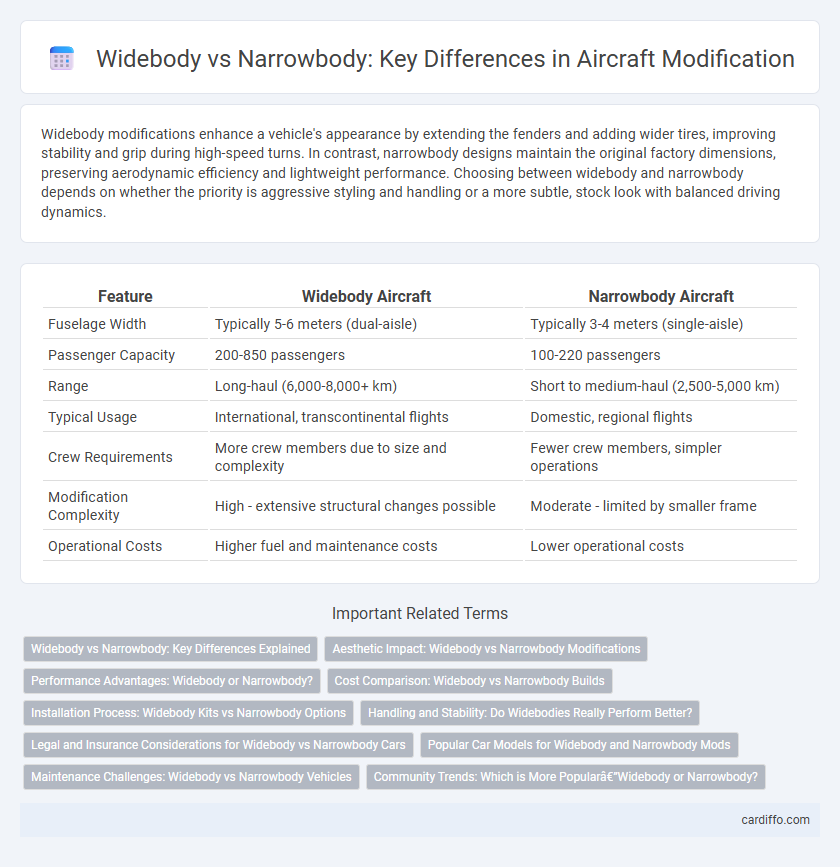Widebody modifications enhance a vehicle's appearance by extending the fenders and adding wider tires, improving stability and grip during high-speed turns. In contrast, narrowbody designs maintain the original factory dimensions, preserving aerodynamic efficiency and lightweight performance. Choosing between widebody and narrowbody depends on whether the priority is aggressive styling and handling or a more subtle, stock look with balanced driving dynamics.
Table of Comparison
| Feature | Widebody Aircraft | Narrowbody Aircraft |
|---|---|---|
| Fuselage Width | Typically 5-6 meters (dual-aisle) | Typically 3-4 meters (single-aisle) |
| Passenger Capacity | 200-850 passengers | 100-220 passengers |
| Range | Long-haul (6,000-8,000+ km) | Short to medium-haul (2,500-5,000 km) |
| Typical Usage | International, transcontinental flights | Domestic, regional flights |
| Crew Requirements | More crew members due to size and complexity | Fewer crew members, simpler operations |
| Modification Complexity | High - extensive structural changes possible | Moderate - limited by smaller frame |
| Operational Costs | Higher fuel and maintenance costs | Lower operational costs |
Widebody vs Narrowbody: Key Differences Explained
Widebody aircraft feature fuselages typically 20 feet or more in diameter, allowing for two aisles and seating configurations that enhance passenger comfort and capacity. Narrowbody planes have single-aisle designs with fuselages generally less than 20 feet wide, optimizing efficiency for short to medium-haul routes. Key differences in modification focus on structural reinforcement, aerodynamic adjustments, and cabin reconfiguration to suit capacity and range requirements.
Aesthetic Impact: Widebody vs Narrowbody Modifications
Widebody modifications significantly enhance a vehicle's aesthetic impact by creating a more aggressive and muscular stance, often featuring extended fenders and wider wheels that draw attention and emphasize performance potential. In contrast, narrowbody modifications maintain the car's original proportions, offering a subtler, streamlined appearance that preserves factory design cues while improving aerodynamics. The choice between widebody and narrowbody modifications ultimately depends on the desired visual statement, with widebody setups favoring bold, race-inspired looks and narrowbody setups emphasizing sleek, understated elegance.
Performance Advantages: Widebody or Narrowbody?
Widebody aircraft offer enhanced aerodynamic efficiency and increased fuel capacity, enabling longer range and improved performance on extended routes. Narrowbody planes excel in agility and lower operating costs, making them ideal for short to medium-haul flights with higher frequency. Performance advantages depend on mission profile, with widebodies suited for transcontinental travel and narrowbodies optimized for regional and domestic operations.
Cost Comparison: Widebody vs Narrowbody Builds
Widebody aircraft builds often involve higher costs due to the increased materials, engineering complexity, and labor required compared to narrowbody builds. Maintenance and fuel efficiency expenses also tend to be greater for widebody modifications because of their larger size and weight. Narrowbody modifications offer cost-effective advantages ideal for short to medium-haul operations, reducing overall project budgets and operational expenditures.
Installation Process: Widebody Kits vs Narrowbody Options
Widebody kits require extensive modification including cutting and reshaping fenders, aligning panels, and reinforcing structural components for proper fitment, often involving professional tools and expertise. Narrowbody options typically offer easier installation with bolt-on components that align with factory mounting points, reducing labor time and complexity. The widebody installation process increases customization potential but demands significant mechanical skill, whereas narrowbody modifications favor quicker, less invasive upgrades.
Handling and Stability: Do Widebodies Really Perform Better?
Widebody aircraft exhibit enhanced handling and stability due to their increased wingspan and broader fuselage, which provide greater lift and improved aerodynamic efficiency during flight. The wider stance contributes to better balance and reduced lateral movements, especially in turbulent conditions, making them more stable than narrowbody planes. These design features enable widebodies to maintain smoother flight profiles, particularly on long-haul routes or when carrying heavier payloads.
Legal and Insurance Considerations for Widebody vs Narrowbody Cars
Widebody cars often face stricter legal regulations due to extended fender widths affecting road safety compliance, requiring specific modifications to pass inspections. Insurance premiums for widebody vehicles tend to be higher because of increased repair costs and elevated risk perception by insurers. Narrowbody cars generally benefit from lower legal scrutiny and insurance rates, making them a more cost-effective option for daily driving modifications.
Popular Car Models for Widebody and Narrowbody Mods
Popular car models for widebody modifications include the Nissan GT-R, Toyota Supra, and Ford Mustang, as these vehicles offer ample chassis strength and aftermarket support for aggressive fender flares and aerodynamic enhancements. Narrowbody modifications are commonly applied to models like the Honda Civic, Mazda MX-5 Miata, and BMW 3 Series, where subtle aesthetic upgrades and minor body adjustments maintain factory proportions for improved performance and street legality. The choice between widebody and narrowbody modifications depends on the desired balance of visual impact, handling dynamics, and customization level tailored to the specific car model.
Maintenance Challenges: Widebody vs Narrowbody Vehicles
Maintenance challenges for widebody vehicles include higher costs due to larger parts and more complex systems compared to narrowbody counterparts. Widebody aircraft require specialized equipment and longer downtime for inspections and repairs, impacting operational efficiency. Narrowbody vehicles benefit from simpler maintenance logistics and generally faster turnaround times, making them more cost-effective in routine servicing.
Community Trends: Which is More Popular—Widebody or Narrowbody?
Community trends reveal a growing preference for widebody modifications due to their enhanced aesthetic appeal and improved aerodynamic performance. Enthusiasts value the aggressive stance and customization options offered by widebody kits, driving increased demand in forums and social media groups. Narrowbody setups retain popularity for daily drivability and cost-effectiveness, but widebody's visual impact currently dominates community conversations.
widebody vs narrowbody Infographic

 cardiffo.com
cardiffo.com